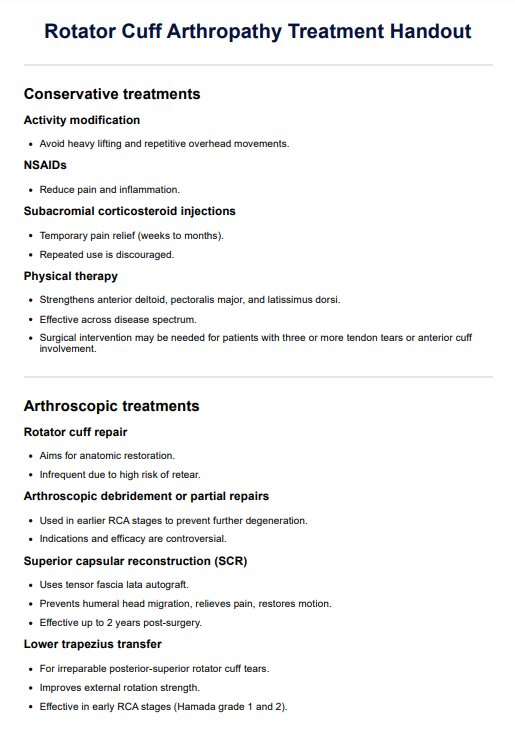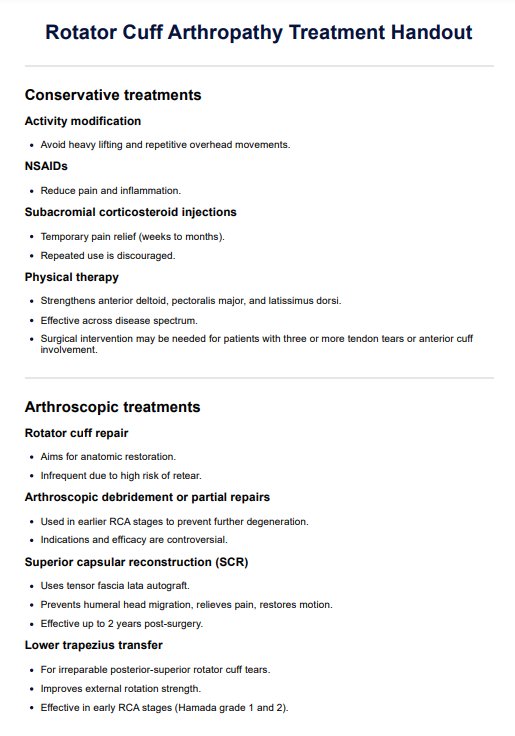Rotator Cuff Arthropathy Treatment Handout
Discover treatment guidelines for rotator cuff arthropathy in Carepatron's free PDF download. Learn more about effectively managing this condition.


What is a rotator cuff tear?
A rotator cuff tear is a common injury affecting the shoulder, particularly the rotator cuff, which is a group of muscles and tendons that stabilize the shoulder joint and allow for a wide range of motion. When the rotator cuff muscles contract, the arm lifts and rotates, making it critical in everyday actgivities.
The rotator cuff tendons can become torn due to acute injury or degenerative changes over time. A rotator cuff tear can be partial, where only some of the fibers are damaged, or complete, where the tendon is entirely severed from the bone. This condition can severely impair rotator cuff function, leading to pain, weakness, and limited mobility in the shoulder.
Rotator cuff tears can result from various causes, including falls, lifting heavy objects, or repetitive overhead activities. In severe cases, such as a massive rotator cuff tear or irreparable rotator cuff tear, the damage may extend beyond the tendons to the surrounding tissues, leading to a condition known as cuff tear arthropathy.
Rotator cuff arthropathy is distinguished from a simple rotator cuff tear by the following key differences:
- Presence of a large, irreparable rotator cuff tear that causes insufficient function of the rotator cuff
- Development of arthritis in the shoulder's glenohumeral joint, where the humeral head and shoulder blade meet
- Shifting of the humeral head away from the glenoid socket due to the cuff tear
This complex condition often necessitates advanced treatments, such as reverse shoulder replacement, to restore function and alleviate pain. The upper arm bone, or humerus, can also be affected by these tears, further complicating the shoulder's biomechanics.
A simple rotator cuff tear, while painful, does not necessarily lead to arthritis if repaired early before significant joint damage occurs. Rotator cuff arthropathy is a more advanced condition that develops gradually over years in patients with large, untreated cuff tears. Understanding the nature of rotator cuff tears is crucial for diagnosing and implementing effective treatment strategies to restore the shoulder's health and functionality.
Rotator Cuff Arthropathy Treatment Handout Template
Rotator Cuff Arthropathy Treatment Handout Example
How to treat rotator cuff arthropathy
Treating rotator cuff arthropathy requires a comprehensive approach to address the degeneration of the shoulder joint caused by a rotator cuff tear. Below are the primary treatment methods to manage rotator cuff arthropathy effectively.
Conservative treatments
Conservative treatments are often the first line of defense for managing rotator cuff tear arthropathy. These treatments focus on alleviating pain and improving shoulder function through non-surgical means. Physical therapy is crucial in strengthening the surrounding muscles and improving the stability of the shoulder joint. Ice and heat therapy help manage pain and inflammation, while anti-inflammatory medications reduce pain and swelling. Corticosteroid injections can provide temporary pain relief for several weeks to months, although they do not heal the tear.
Surgical options
Surgical options may be needed for severe cases. These vary depending on the severity of the rotator cuff tear and the extent of joint damage. Arthroscopic debridement is a minimally invasive procedure used to clean out the damaged tissue within the shoulder joint, removing inflamed tissue, bone spurs, and loose tendon flaps. For more severe cases, particularly when dealing with a massive or irreparable rotator cuff tear, a reverse total shoulder arthroplasty (reverse shoulder replacement) is highly recommended. This procedure involves reversing the ball and socket positions of the shoulder joint, creating a more stable joint that functions without a rotator cuff.
Physical rehabilitation
Post-treatment rehabilitation is essential to regain strength and mobility in the shoulder. Immediate post-surgery rehabilitation begins the day after surgery, focusing on safe movement and basic exercises. Home therapy visits may follow to ensure safe movement and provide treatments. Outpatient therapy offers more intensive therapy, including pain control methods like ice, electrical stimulation, and massage. A structured rehabilitation program tailored to the individual’s needs helps restore the range of motion, strengthen the shoulder muscles, and improve overall joint function.
Lifestyle modifications
Patients are encouraged to avoid activities that exacerbate shoulder pain, such as heavy lifting or repetitive overhead movements. Incorporating low-impact exercises, like swimming or cycling, can help maintain overall fitness without putting undue stress on the shoulder joint. Additionally, learning joint protection tips and safe motions can prevent further damage to the shoulder joint.
How to use our treatment guidelines handout template?
To effectively utilize our Rotator Cuff Arthropathy Treatment Guidelines Handout, follow these steps designed for healthcare professionals to guide patient treatment and ensure comprehensive care.
Step 1: Access the template
Download the treatment guidelines handout template from the Carepatron website or access it via the Carepatron app. Ensure you have the latest version for accurate and up-to-date guidelines.
Step 2: Use the template as a reference in treatment planning and execution
Refer to the template while developing and executing treatment plans. The template provides a structured approach to managing rotator cuff arthropathy, helping you outline the necessary steps for patient care.
Step 3: Document treatment and monitor progress
Ensure that you document every step and development in the treatment to make monitoring easy. Regularly update your patient progress notes, including any changes in symptoms, treatment responses, and modifications to the treatment plan. This helps track the patient’s recovery and adjust the care plan as needed.
Benefits of using this handout
Carepatron's Rotator Cuff Arthropathy Treatment Guidelines Handout offers several advantages for medical professionals. This handout is designed to streamline the treatment process and ensure comprehensive patient care.
Improved clinical efficiency
The handout provides clear and concise guidelines for diagnosing and treating rotator cuff tear arthropathy, allowing healthcare professionals to quickly access necessary information. This efficiency saves time during consultations and follow-up appointments, ensuring that patients receive timely and effective care.
Enhanced patient education
With detailed explanations and easy-to-follow instructions, the handout helps medical professionals educate patients about their condition and treatment plan. This understanding empowers patients to actively participate in their recovery process, leading to better adherence to treatment protocols and improved outcomes.
Consistent treatment protocols
Carepatron's handout ensures that all healthcare professionals within a practice or healthcare facility follow consistent treatment protocols. This standardization improves the quality of care and reduces the risk of errors or omissions, resulting in more reliable and effective management of rotator cuff arthropathy.
Commonly asked questions
Rotator cuff arthropathy is treated with a combination of conservative methods like physical therapy and pain management, or surgical intervention in severe cases such as reverse shoulder replacement.
Healing time for a torn rotator cuff without surgery varies but can take several months to over a year, depending on the tear's size and location, as well as the effectiveness of conservative treatments.
Rotator cuff surgery may be less effective or not recommended if the tear has progressed to irreparable damage, leading to significant muscle atrophy or long-term stiffness in the shoulder joint.







































































































